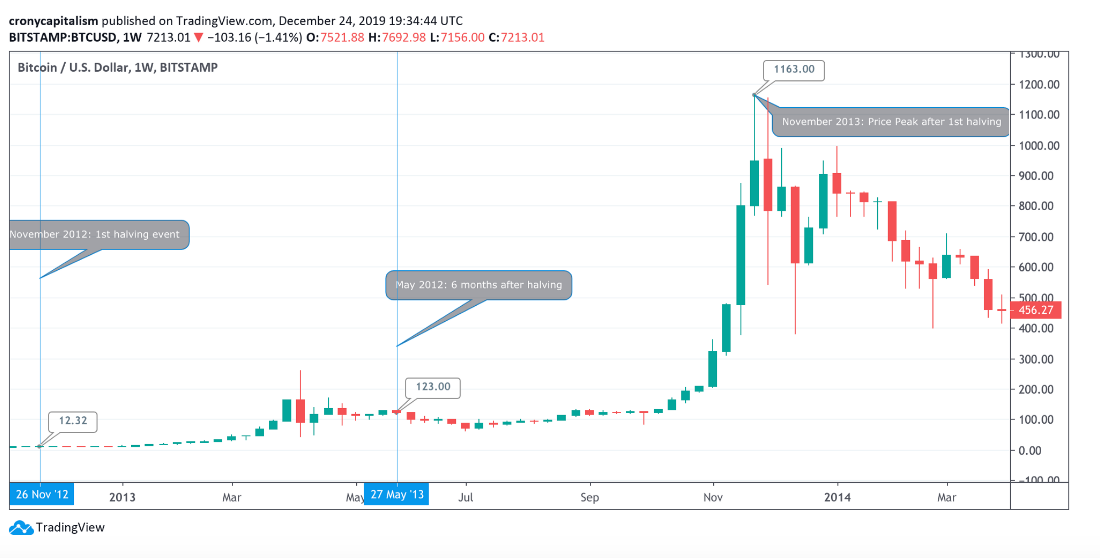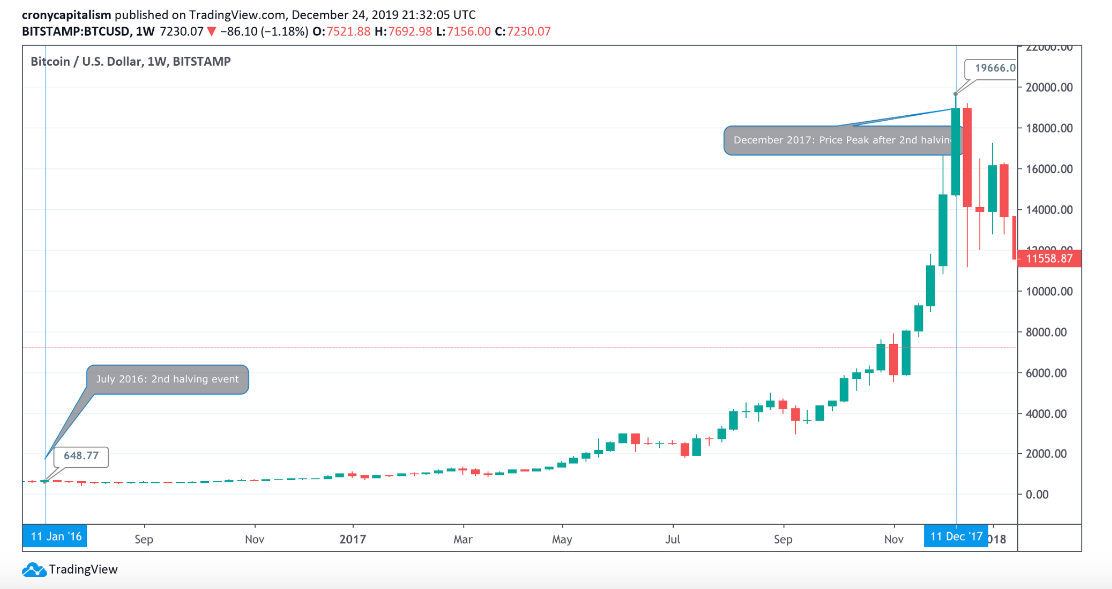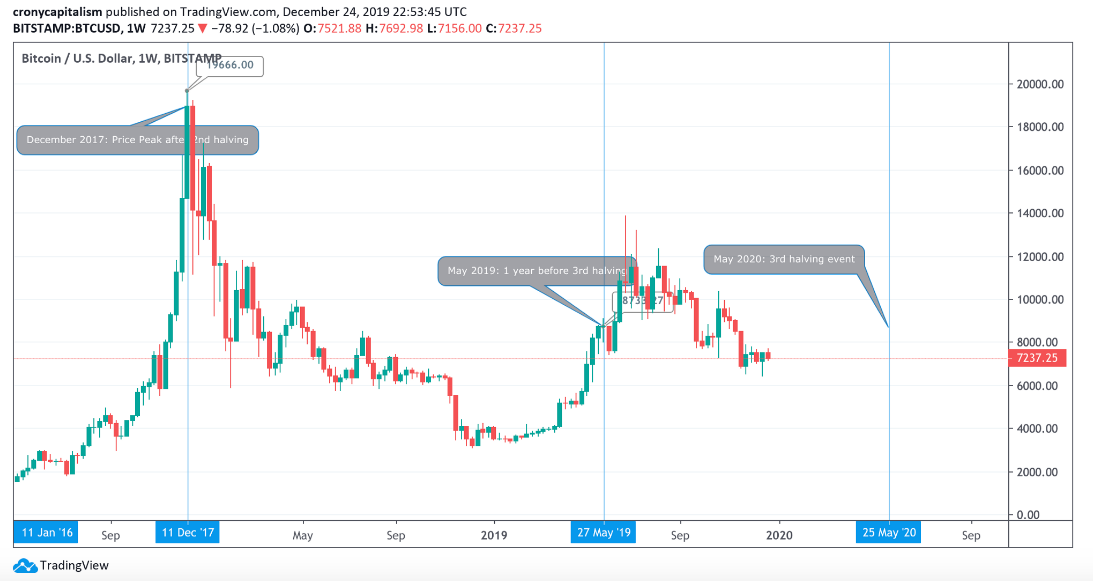
The world’s best-known cryptocurrency Bitcoin emerged amidst the 2009 financial crisis. It’s a paradox that after more than 10 years when it’s in a turning point to become a more mature asset, it’s a global crisis again. Maybe it is the destiny of Bitcoin to be marked by economic recessions, but let’s have a look if it has the potential to go up within 2020.
Created as a reward for a competitive and decentralized process called mining, Bitcoin has gone a long way during the decade of its existence. With the intention to become an alternative for banks and financial institutions, Bitcoin first had to overcome a number of scandals.
Frauds, thefts, illegal usage on darknet threw a shadow on its reputation and brought closer regulatory scrutiny. But once it burst into the mainstream, it proved to be the decade’s best-performing asset.
Even with prices high up to nearly $20.000 and a dramatic crash to $3.300, Bitcoin’s performance over the last 10 years was so unique that nothing else comes even close to beating it. The leading digital coin increased its value by nearly 9 million percent over the past decade.

But in times when coronavirus pandemic causes the biggest recession in a century, Bitcoin might act as a more predictable asset. And this is because now there are important fundamentals that drive both the global economy and Bitcoin itself. Let’s have a look at them.
Positive correlation with traditional markets
The dramatic market crash on March 12th impacted cryptocurrency and stock markets around the world. Both of them experienced historical losses. Bitcoin’s price dropped nearly 50% overnight.
The crash was mainly caused by the massive sell-offs when traders and investors fell into a panic over the COVID-19 breakout and oil wars between Saudi Arabia and Russia.
Sponsored
Meanwhile, the moment revealed the surprising fact: the leading decentralized crypto asset Bitcoin showed a positive correlation with the traditional S&P 500 index and gold. This means that both categories of assets are dependent and move in tandem with each other. The fact is not typical for Bitcoin, which always has been perceived as digital gold due to decentralized nature and weak relationships with traditional assets, like stocks.
Financial experts claim that correlation is strongest when both markets are falling. Meanwhile, experts predict that as long as the global economic crisis will be affecting both markets, there might be a relatively high correlation between Bitcoin and traditional indexes.
Bull run Bitcoin price forecast
So, how does this affect the price of Bitcoin? A recent study from Bloomberg Intelligence confirmed Bitcoin is in the gold-like transition process. This means that the crypto coin, often called digital gold, becomes more immune to negative market shock. Analytics suggests that Bitcoin’s volatility will continue to decrease in 2020.
This year will confirm Bitcoin's transition from a risk-on speculative asset to the crypto market's version of gold.
Meanwhile, Bitcoin appears to be marking time before following the gold bull market. Having in mind a positive correlation, this is a good sign for Bitcoin price prediction because of one important reason. The unprecedented US monetary stimulus, that is the big step for the recovery and new highs of the gold price. Thus, Bitcoin, as well as gold, is expected to win the most from the COVID-19 induced market turmoil.
The effect of Bitcoin futures
Speaking about the maturing of Bitcoin, correlation is not the only factor. The experts agree that Bitcoin’s participation in the derivatives market is equally important as it is shaping the character of the world’s best-known cryptocurrency. The Bitcoin stepped into the derivative markets as its futures contracts became available on cryptocurrency exchanges at the end of 2017.
Bitcoin futures – or futures contracts – is a legal agreement to buy or sell a Bitcoin at a predetermined price at a specified time in the future. The technique helps to hedge positions and reduce the risk.
According to Bloomberg’s report, Bitcoin futures are the ones that made an impact on the benchmark crypto coin. With investors, and especially the institutional ones, showing interest in Bitcoin’s acquisition, the volume of futures contracts is gradually increasing. The fact of institutional trust automatically represents the taming of the highly speculative bull market.
Increasing futures open interest, declining volatility and relative outperformance despite the stock-market shakeout indicates Bitcoin is maturing from a speculative crypto asset toward a digital version of gold. On a one-year basis, Bitcoin is up about 40%.
Since futures contracts helped to establish the decentralized digital asset as a more stable investment, it’s price fluctuations are supposed to become less sharp.
On the other hand, the more Bitcoin becomes an investable asset, the more it’s price becomes decoupled from its value and its supply and demand. And if the derivatives dominate Bitcoin trading, there might be a real possibility that Bitcoin price prediction might not be highly optimistic after the halving.
2020 Bitcoin halving price prediction
The third Bitcoin halving is expected on May 11th. The process when the number of new Bitcoins issued every 10 minutes is cut in half, happens every 4 years, and is a big thing for the whole crypto community.
Historically the previous Bitcoin halvings of 2012 and 2016 resulted in higher demand and consequently higher prices. However, the current circumstances are not the same as they were four years ago when the latest Bitcoin halving occurred, making Bitcoin price forecast more complicated.
When the first halving happened in November 2012, Bitcoin was still not a well-known digital asset outside the developers’ community. At a time the price of Bitcoin was around $12. In a year after the halving, it catapulted to over $1.100, increasing nearly 110 times.

Meanwhile, the last halving in July of 2016 led to an even bigger increase in Bitcoin’s price. During this time, Bitcoin was worth about $650. The halving inspired a massive bull run of about 18 months. The price of Bitcoin skyrocketed over 3.000% to nearly $20.000 per coin at the peak of the uptrend in late 2017.

Optimistic third Bitcoin halving forecast
The third Bitcoin halving is coming in a few weeks from the time of publishing. It is difficult to make price predictions based on fundamental analysis since Bitcoin is facing its first test of macroeconomic recession and no one is certain what the future brings. However, with massive coronavirus stimulus packages issued by various governments around the world, a bullish effect on cryptocurrency with limited supply might become very possible.
Furthermore, historical price charts show the traditional increase in Bitcoin’s price before halving, which works as acceleration for further price growth. Following the tendency, there currently might be some bright insights in Bitcoin’s future price.
Despite the fact that Bitcoin free-fell to around $4.700 during the March 12th market crash and lost nearly half of its value, it has rallied to its current value of nearly $7.400 at the time of writing.
If Bitcoin will repeat what it did after the previous two halving’s, then at least 1.000% post halving gain might not be uncommon. Having in mind that Bitcoin enters an extended bull market after each halving, which lasts for at least a year, the Bitcoin price prediction 2021 might be the price at least 10 times higher than it is today. From the current price of around $7.500, a minimum gain of 1.000% will bring Bitcoin at a price of $74.000.

Reserved third halving forecast
And yet, however, there is one very important moment, that brings price predictions back to earth. The upward price trend, that forms approximately a year before the halving. It was clearly formed before 2012 and 2016 halving. Meanwhile, in the 2020 case, the long-term charts show that Bitcoin still remains in a downtrend.
This means that even though Bitcoin might rally to some extent, the sell-offs will inevitably happen as traders and investors will reach the right moment. According to Bitcoin price prediction 2020 done by popular analytical website TradingBeast, the downtrend should further deepen during the year keeping the Bitcoins price at a maximum $8.000 level.

To conclude, 2020 will definitely be an important year for the world’s leading cryptocurrency. Despite the fact that Bitcoin is going through its first test of the global economic crisis, it has the chance to gain more solid status than ever before.
Even though its correlation with traditional and gold markets remains positive due to recession, the massive monetary stimulus for global economies is supposed to lift up both traditional and cryptocurrency markets.
Meanwhile, Bitcoin futures contracts might reduce its price volatility and tame the leaping bull trends, which means that price fluctuations won’t be so sharp and price predictions will become more reserved. Despite the fact, the increasing interest from institutional investors shows their bigger trust in Bitcoin.
And finally, Bitcoin halving. The process traditionally marks the following increase in Bitcoin’s price. However, the 2020 halving differs from previous ones due to the current Bitcoin’s price downtrend. With all these factors in mind, predictions for Bitcoin price growth remain cautiously positive.
